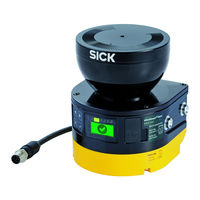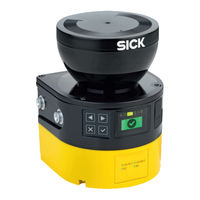SICK microScan3 - EFI-pro Laser Scanner Manuals
Manuals and User Guides for SICK microScan3 - EFI-pro Laser Scanner. We have 8 SICK microScan3 - EFI-pro Laser Scanner manuals available for free PDF download: Operating Instructions Manual, Technical Information, Mounting Instructions
SICK microScan3 - EFI-pro Operating Instructions Manual (160 pages)
Safety
Table of Contents
-
-
-
-
Variants15
-
-
Status Leds15
-
Connections16
-
System Plug17
-
Field Types17
-
-
-
Field Set19
-
-
-
Assembly24
-
-
Power Supply51
-
Ossds52
-
-
-
OFF State56
-
-
Testing Plan59
-
5 Mounting
63 -
-
Safety69
-
-
-
-
Projects73
-
User Groups74
-
Overview75
-
Application79
-
Application80
-
Fields86
-
Simulation98
-
Transfer100
-
Reports101
-
Service102
-
Device Restart102
-
Factory Settings103
-
-
8 Commissioning
105-
Safety105
-
Alignment105
-
Switching on106
-
Thorough Check107
-
Status Leds107
-
-
9 Operation
109-
Safety109
-
Leds109
-
Status Leds110
-
-
10 Maintenance
114-
Safety114
-
Regular Cleaning114
-
-
-
Safety121
-
Diagnostic Leds121
-
Status Leds121
-
-
-
Status Display122
-
-
Status Leds122
-
-
Fault Display125
-
-
Fault Types126
-
-
Data Recorder128
-
-
Data Recorder129
-
Message History130
-
-
-
-
Variant Overview132
-
Data Sheet132
-
Microscan3 Core132
-
-
Response Times137
-
Switch-Off Tests138
-
Sensing Range139
-
-
15 Spare Parts
143 -
16 Accessories
144-
Brackets144
-
Mounting Kit 1A144
-
Mounting Kit 1B145
-
Mounting Kit 2A145
-
Alignment Aid146
-
Cleaning Agent146
-
-
17 Glossary
147 -
18 Annex
151
Advertisement
SICK microScan3 - EFI-pro Operating Instructions Manual (160 pages)
Core I/O AIDA Safety laser scanner
Table of Contents
-
-
-
-
Variants15
-
Status Leds15
-
Connections16
-
System Plug16
-
Field Types16
-
-
-
Field Set18
-
-
-
Ardous Area18
-
-
-
Assembly21
-
-
Ossds49
-
Testing Plan51
-
5 Mounting
55 -
-
Safety61
-
-
-
-
Projects65
-
User Groups66
-
-
Settings67
-
-
User Groups67
-
Overview70
-
Application74
-
Fields81
-
Field Editor82
-
Simulation96
-
Transfer97
-
Reports98
-
Report98
-
Service99
-
Factory Settings100
-
8 Commissioning
102-
Safety102
-
Alignment102
-
Switching on103
-
Thorough Check104
-
Status Leds104
-
-
9 Operation
106-
Safety106
-
Leds106
-
Status Leds107
-
Menu110
-
-
10 Maintenance
111-
Safety111
-
Regular Cleaning111
-
-
-
Safety118
-
Diagnostic Leds118
-
Status Leds118
-
-
-
Status Display119
-
-
Status Leds119
-
Menu121
-
Fault Display122
-
-
Fault Types123
-
-
Data Recorder124
-
Event History126
-
Message History128
-
-
-
-
Variant Overview130
-
Compatibility130
-
Data Sheet131
-
Features131
-
Interfaces133
-
Electrical Data133
-
Mechanical Data134
-
Ambient Data134
-
Response Times135
-
Sensing Range137
-
Switch-Off Tests137
-
-
15 Spare Parts
141 -
16 Accessories
142-
Brackets142
-
Mounting Kit 1A142
-
Mounting Kit 1B143
-
Mounting Kit 2A143
-
Mounting Kit 2B144
-
Alignment Aid145
-
Cleaning Agent145
-
Test Rods145
-
-
17 Glossary
146 -
18 Annex
149
SICK microScan3 - EFI-pro Operating Instructions Manual (192 pages)
Safety laser scanner
Brand: SICK
|
Category: Security Sensors
|
Size: 17 MB
Table of Contents
-
Scope8
-
Intended Use11
-
Status Leds15
-
Variants16
-
Connections17
-
System Plug17
-
Field Types17
-
Field Set20
-
Ardous Area22
-
Assembly25
-
EFI-Pro55
-
Testing Plan59
-
Mounting63
-
Safety63
-
Unpacking63
-
Safety71
-
Projects74
-
User Groups75
-
Settings76
-
Overview79
-
Addressing82
-
Application86
-
Fields92
-
Field Editor93
-
Monitoring Cases105
-
Input Conditions107
-
Cut-Off Paths107
-
Simulation109
-
Data Output110
-
Transfer111
-
Reports113
-
Report113
-
Service114
-
Device Restart114
-
Ethernet/Ip115
-
Factory Settings115
-
Commissioning117
-
Safety117
-
Alignment117
-
Switching on118
-
Thorough Check119
-
Operation121
-
Safety121
-
Leds121
-
Status Leds121
-
Menu126
-
Maintenance128
-
Safety128
-
Regular Cleaning128
Advertisement
SICK microScan3 - EFI-pro Operating Instructions Manual (212 pages)
Safety laser scanners
Table of Contents
-
Scope8
-
Intended Use11
-
Variants15
-
Connections16
-
System Plug16
-
Field Types17
-
Field Set20
-
Assembly26
-
Profinet62
-
Testing Plan70
-
Mounting76
-
Safety76
-
Unpacking76
-
Safety81
-
Projects85
-
User Groups87
-
Settings88
-
Networking90
-
Overview91
-
Profinet94
-
Profinet98
-
Application100
-
Monitoring Plane101
-
Fields107
-
Background Image111
-
Monitoring Cases119
-
Input Condition121
-
Cut-Off Paths121
-
Simulation123
-
Data Output124
-
Transfer125
-
Reports128
-
Service129
-
Device Restart129
-
Factory Settings129
-
Commissioning133
-
Safety133
-
Alignment133
-
Switching on134
-
Operation136
-
Safety136
-
Status Leds136
-
Network Leds137
-
Maintenance142
-
Safety142
-
Regular Cleaning142
SICK microScan3 - EFI-pro Operating Instructions Manual (200 pages)
EtherNet/IP.
Safety laser scanner
Brand: SICK
|
Category: Security Sensors
|
Size: 19 MB
Table of Contents
-
-
-
Variants16
-
Connections17
-
System Plug17
-
Field Types17
-
Field Set20
-
-
Assembly25
-
-
Ethernet/Ip54
-
Testing Plan64
-
5 Mounting
67 -
-
-
Projects78
-
User Groups80
-
Settings80
-
Overview83
-
Addressing85
-
Application88
-
Fields95
-
Monitoring Cases105
-
Simulation109
-
Data Output110
-
Transfer111
-
Reports113
-
Service114
-
Device Restart114
-
Ethernet/Ip115
-
Factory Settings115
-
-
8 Commissioning
117-
Safety117
-
Alignment117
-
Switching on118
-
Thorough Check119
-
-
9 Operation
121 -
10 Maintenance
127
SICK microScan3 - EFI-pro Technical Information (64 pages)
Safety laser scanner, Data output via UDP and TCP/IP
Table of Contents
-
-
Data Sheet18
-
-
7 Annex
19
SICK microScan3 - EFI-pro Mounting Instructions (19 pages)
Safety laser scanners PROFINET RJ45, SCRJ
Table of Contents
SICK microScan3 - EFI-pro Mounting Instructions (19 pages)
Safety laser scanner, EFI-pro/EtherCAT/PROFINET (M12)/EtherNet/IP
Table of Contents
Advertisement







